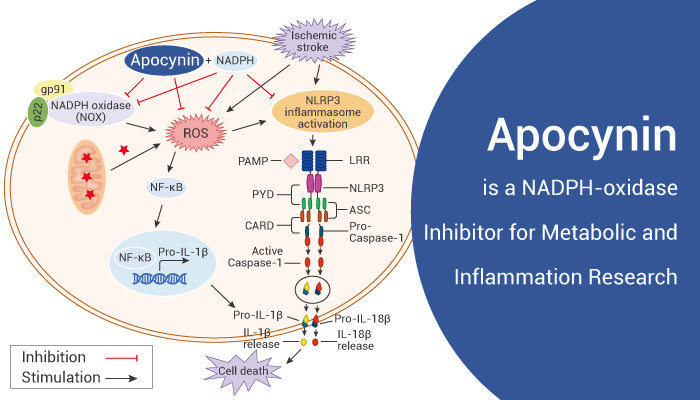Oxidative stress describes an imbalance between reactive oxygen species (ROS) synthesis and antioxidants. Normally, cells possess antioxidant defense systems that include ROS degrading molecules (ROS scavengers), such as uric acid, and antioxidant enzymes, such as catalase. However, in pathologic conditions, in which excessive production of ROS outstrips endogenous antioxidant defense, oxidative stress may irreversibly modify (oxidize) biologic macromolecules (such as DNA, protein, carbohydrates, and lipids). In addition, ROS induce apoptotic cell death in various cell types, and deregulation of apoptosis causes clinical disorders. Interestingly, NADPH-oxidase is the enzyme responsible for ROS production. That’s to say, inhibition of this enzyme represents an attractive therapeutic target for the treatment of many diseases. Hence, we will introduce a NADPH and NOX inhibitor-Apocynin.

Apocynin is an orally active and selective NADPH-oxidase inhibitor (IC50=10 μM).
In vitro, Apocynin (1, 10, 100 μM; 3, 6, 12 h) decreases the intracellular ROS level in HR-3Y1-2 but not 3Y1 cells. In addition, Apocynin (100 μM; 1-7, 14 days) shows a significant increase in the expression level of an osteogenic marker in the aging BMSCs after osteogenic induction. Besides, Apocynin (1, 10, 100 μM, 0-48h ) has selective inhibition the proliferation and adhesion to fibronectin of v-H-ras-transformed 3Y1 cells.
Apocynin not only shows exhibits good activity of inhibiting NOX, but also improves acute lung inflammation in mice model.
Apocynin (0.1 mg/kg/day, i.p., three times per week for 3 months) increases bone mineral density and total bone volume in SAMP6 mice. Moreover, Apocynin (5 mg/kg, i.p.) reduces the degree of lung injury and attenuates the degree of acute inflammation in the Carrageenan (HY-125474)-induced pleurisy mice.
In a word, Apocynin is a promising NOX inhibitor for metabolic, inflammation and cancer research.
Reference:
[1] Stefanska J, et al. Mediators Inflamm. 2008;2008:106507. https://pubmed.ncbi.nlm.nih.gov/19096513/
[2] Stolk J, et al. Am J Respir Cell Mol Biol. 1994 Jul;11(1):95-102. https://pubmed.ncbi.nlm.nih.gov/8018341/
[3] Sun J, et al. Sci Rep. 2015 Dec 21;5:18572. https://pubmed.ncbi.nlm.nih.gov/26686764/
[4] Yamasaki M, et al. Biosci Biotechnol Biochem. 2012;76(6):1177-81. https://pubmed.ncbi.nlm.nih.gov/22790943/